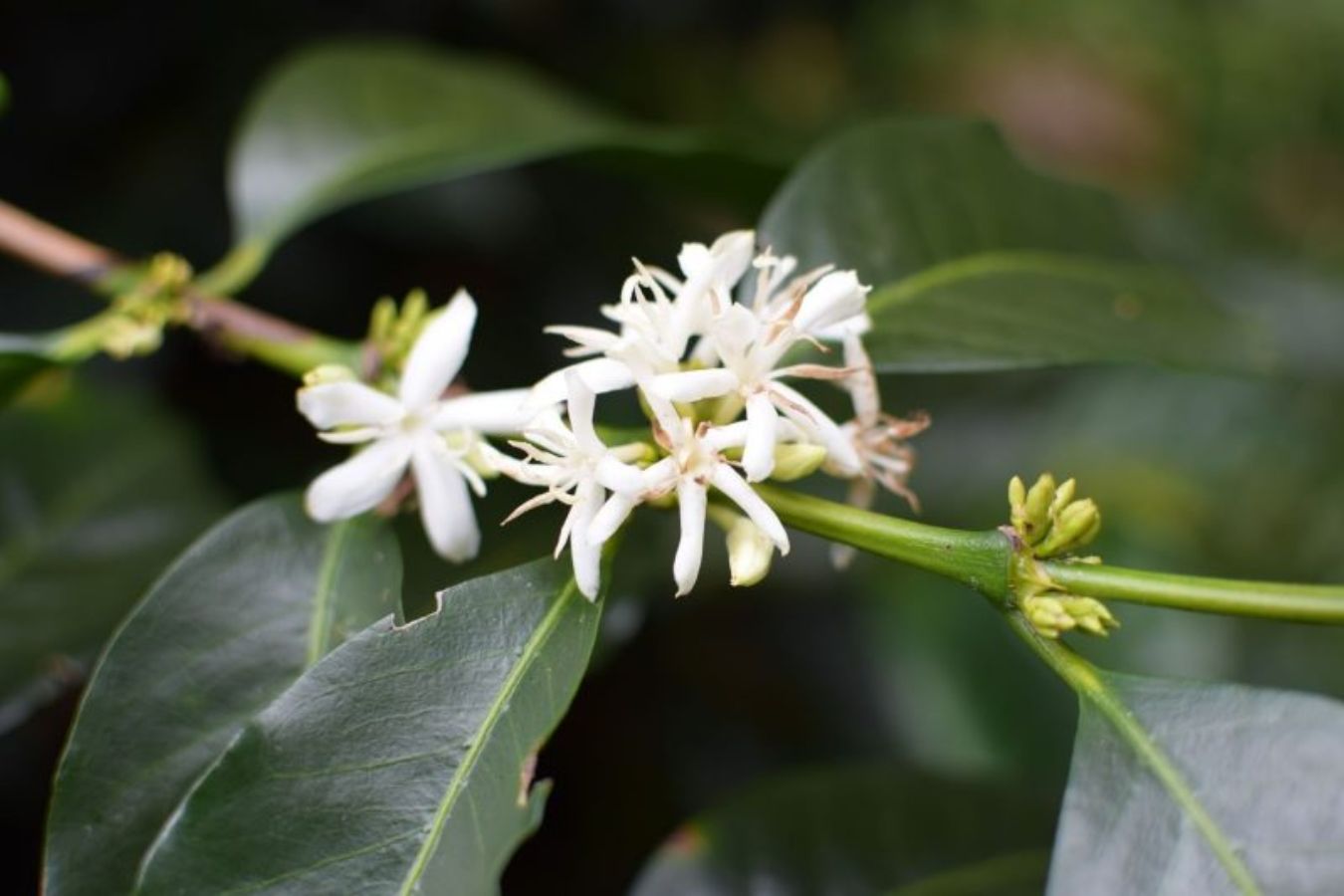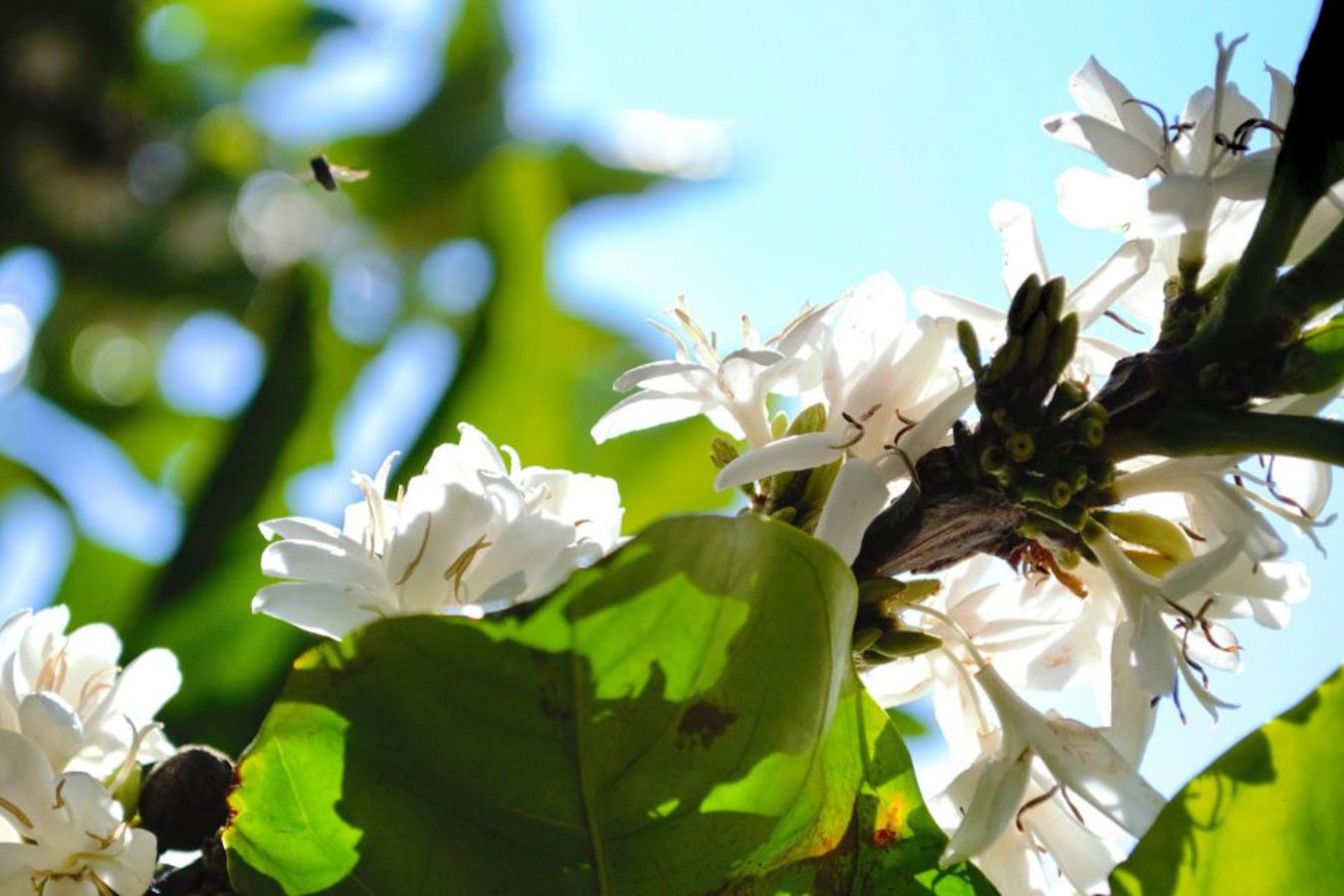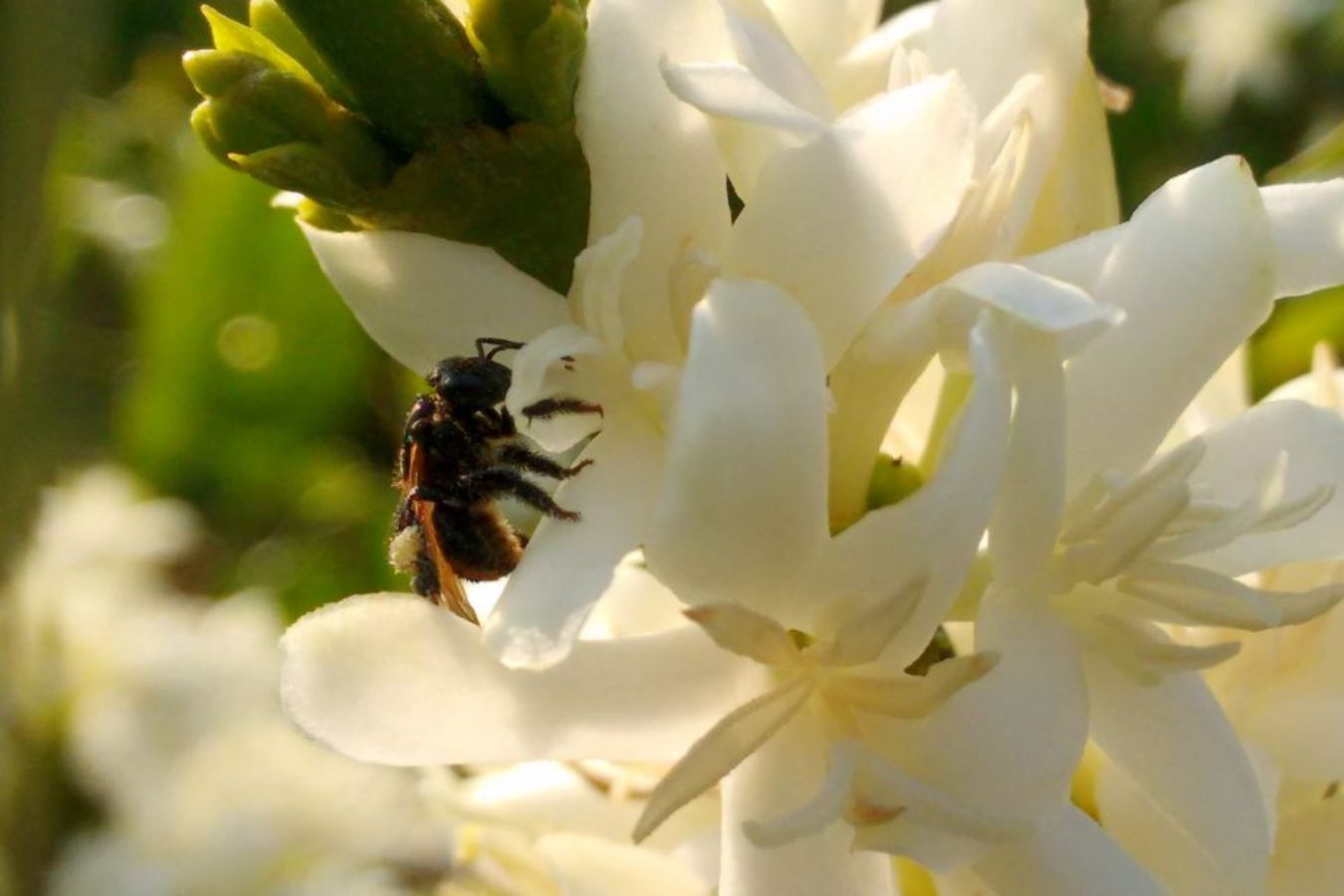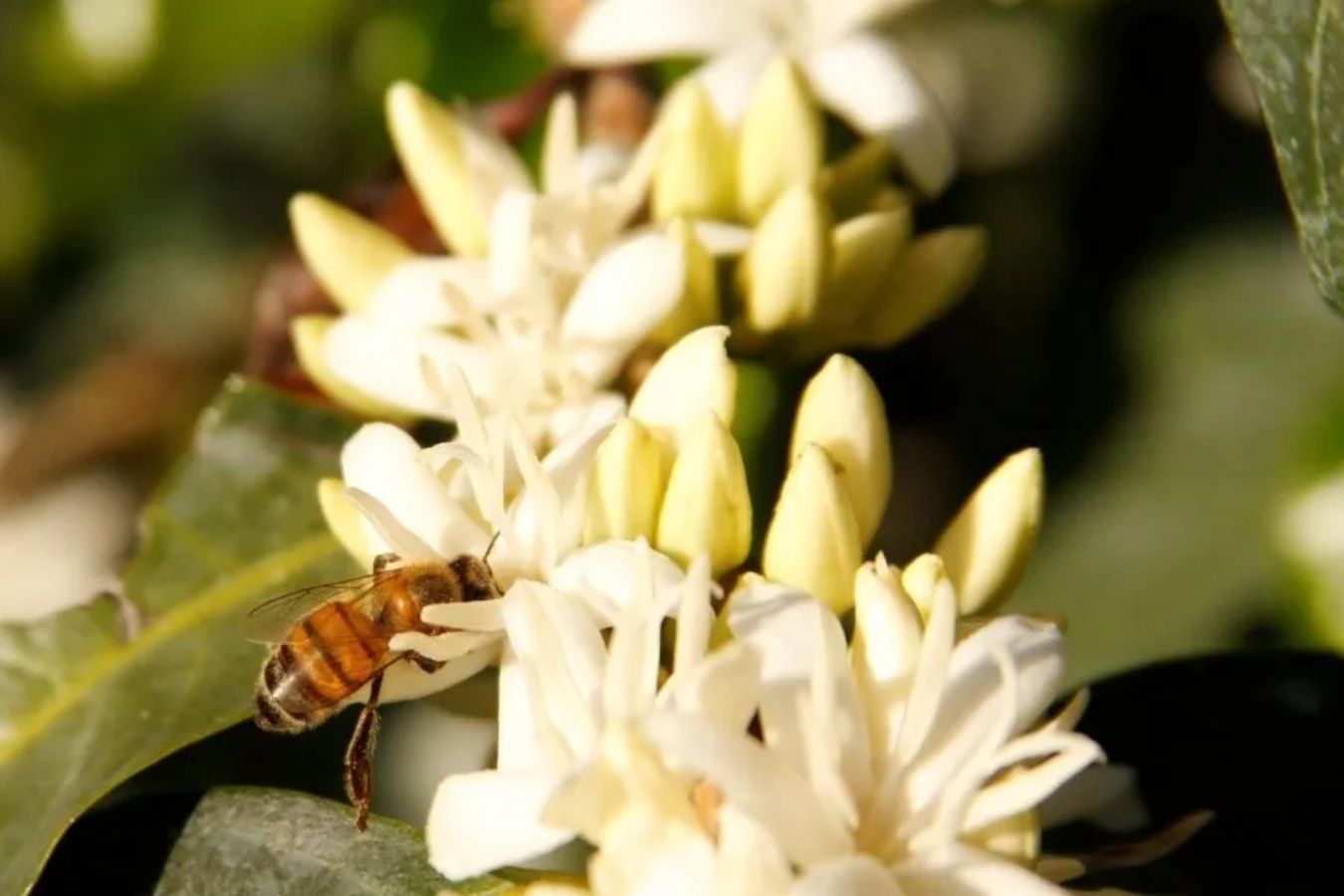
The blooming seasons differ around the world depending on the climate. Rainfall is critical to the coffee tree’s seasonal survival at the right time. However, farmers find it increasingly impossible to predict the blossoming season with rising temperatures, uncertain droughts, and unpredictable rain.
Flowers Of Coffee Occurred
It’s the flowering season!
Coffee plants flower three to four years after they are planted on average. The flowering time is approximately 2-3 months. Each flower bud can produce up to four blooms, which grow in clusters along the leaf’s axis (stem). When the flowers bloom, they have a jasmine-like scent.

It’s important to remember that the flowering stage varies significantly between species. While Arabica plants may self-pollinate, Robusta plants require cross-pollination to thrive. Robusta coffee blossoms are more extensive and numerous than arabica coffee flowers. (From 8 to 20 panicles per panicle, versus 2 to 12 for Arabica.)
Coffee blossoming conditions (process)
The coffee plant requires significant rainwater for the blossom to flourish. The shoots along the trunk will begin to flower a few weeks after the season’s first rains. Flowering is a delicate process, and plants require steady space for optimal growth. In most circumstances, the farmer will leave the garden at this moment.
At the “peak” of the blossoming season, the perfume of coffee flowers reaches its highest power around four weeks later. This is frequently regarded as a cause for celebration in coffee-growing regions. Because the flowers only last approximately three days before wilting and falling to the ground. It’s also an indication that the berries are almost ready to ripen.
Some couples even plan weddings around this season to take advantage of the fields of white flowers’ unusual beauty and intense aroma.
Stage of flowering
The carpel is a spherical tube left behind after the coffee blooms have fallen to the ground. Over the next few months, it transforms into a coffee fruit. These carpels spread and grow until they achieve their full potential. The ripening process will commence at this point.

The coffee fruit is created in the newly developed tissues of these carpels. As a result, blossoms can be harvested without influencing the fruit’s development. In some situations, coffee-growing regions have even used coffee flowers to diversify their incomes. They are helpful because they may prepare tea and other beverages.
What Makes Coffee Fowers So Important?
Uniform flowers indicate that ripening will be uniform. As a result, the coffee berries are of more excellent quality.
A variety of factors can cause uneven flowering.
Uniform blooms, on the other hand, require consistent and regular rainfall. Rainfall is becoming increasingly irregular in coffee-growing regions due to climate change.
The Earth’s atmosphere holds more moisture as the temperature rises. This results in more significant rainfall, but it is not evenly distributed around the globe.
Unusual bloom patterns can occur when rainfall is unpredictable. Pollination of flowers on the same tree or branch might occur at various times. As a result, there are many stages of maturity. Crops might be harmed in areas with a lot of rain or storms.
The significance of coffee flowering at the same time
It’s critical to maintain consistency within a single manufacturing facility. If a farmer grows coffee with an inconsistent crop, ripe and unripe berries – or healthy and damaged berries – on the same branch. They must harvest them at various periods. The coffee will have no choice but to be harvested by hand. A process that takes longer and involves more effort.
Harvesting cherries by hand, on the other hand, involves focusing on quality in some regions because it can ensure greater homogeneity.
Due to climate change, erratic rain patterns and wide temperature swings will continue to occur in the future, and they will almost certainly become more damaging.
Coffee flower blooming
Temperature, like rainfall, is a significant component in coffee plant growth. Regardless matter where coffee is grown, scientists believe that a low temperature of 19 to 24o C is ideal for initiating the flowering process.
However, flowering times may become less predictable as global average temperatures rise. This makes picking coffee more difficult (and subsequently more expensive).
An only temporary adaptation
For coffee farmers, the weather is becoming increasingly hot. They usually make do by relocating to higher elevations with smaller temperature ranges. However, this comes with a slew of other issues. Higher elevations feature steeper and rougher terrain, which means there is less space to grow coffee, and harvesting becomes more challenging.
Coffee Flowering And Irrigation
For coffee plants, adequate natural rain is the ideal source of moisture. It promotes flowering and improves the soil’s roots’ absorption of nutrients and minerals.
However, it is necessary to ensure that the coffee plants are adequately hydrated and cared for during the crop. Regardless of how consistent the rainfall is, many farmers prefer to use irrigation.
Irrigation techniques used in the past
There are three standard techniques for watering coffee in the typical watering system:
Water is dispersed over the soil surface by gravity in surface irrigation (e.g. top-to-bottom flow)
Drowning in the neighbourhood: Irrigate the soil just near each plant.
Irrigation by sprinkler: Irrigate crops by placing sprinklers in rows above or between the plants.
Limit the amount of water you use
Coffee growers are now experimenting with a revolutionary irrigation approach known as “controlled watering.”
This method entails restricting plant irrigation to promote more uniform flowering. This metric has grown in popularity over time.

By not watering for an extended period (2 two months). Gardeners will have more control over flowering when the weather warms up again. As a result, the coffee berries will grow more evenly. As a result, the coffee’s uniformity and quality at harvest will improve.
According to several research released by this organization, coffee trees with reasonable water control flower and develop fruit more evenly. However, the next harvest will yield a higher yield. The productivity index of some coffee farms surveyed has risen by 15%.
For Even Production, The Best Work
Even with uncertain rainfall and high-temperature variations, ensuring a consistent flowering time is doable.
However, it should be highlighted that growers must be aware that watering coffee plants earlier in the season (through irrigation or rainfall) raises the risk of some diseases.
Climate change creates a favourable environment for fungi to attack crops (such as coffee leaf rust). Rain that arrives earlier than expected has a higher possibility of triggering them. On the other hand, Fungicides can be used to prevent these illnesses.
For uniform yield and flowering, careful attention to macro-and micronutrients, pest and disease control, and the use of bio-fertilizers are increasingly suggested.
Drought and heat have a significant impact on these projects. These variables can prevent the production of growth inhibitors later in life.